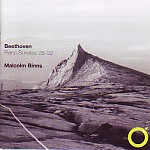In the late 1970s Malcolm Binns became the first pianist to record all 32 Beethoven piano sonatas on period keyboard instruments. The cycle appeared in a series of boxed sets on the L’Oiseau-Lyre label and never was issued on CD–until now. Each of the last five sonatas features a different instrument, and the unusually vivid engineering certainly helps listeners assess timbral similarities and differences between them. Interestingly, both the oldest and most recent fortepianos (an 1814 Graf and an 1825 model by Georg Haschka) retain the most pronounced harpsichord-like “twang” in the upper register’s highest octave. Given the lighter action and tactile immediacy characterizing such instruments, it would stand to reason that they lend themselves to the faster tempos fashionable among many of today’s early-piano practitioners.
Indeed, you might argue that Beethoven’s optimistic metronome markings for the Hammerklavier (Op. 106) are more viable on the fortepiano than on the heavier-action modern grand. That said, Binns generally favors measured tempos and enough rhetorical legroom to channel the spirit of Furtwängler. In other words, he’s Claudio Arrau trapped in Robert Levin’s body!
Slow movements and extended lyrical sequences elicit Binns’ best playing. Notice the proportioned poetry he brings to Op. 109’s first movement, the Hammerklavier’s great Adagio, the Adagio ma non troppo leading into and including the beginning of Op. 110’s fugue, and the long introduction to the Hammerklavier’s fugue. By contrast, Binns treads the knotty passagework in Op. 111’s first movement with inhibition and lacks rhythmic ferocity in Op. 101’s March movement and the fugal finale. Op. 109’s second movement is a shade square and anything but the Prestissimo Beethoven specifies, while Binns underplays Op. 110’s second-movement accents and rhythmic displacements.
So far as individual releases of Beethoven sonatas on fortepiano go, the catalog offers slim pickings. To my mind, Peter Serkin’s incisive, imaginative Graf fortepiano accounts of the last six sonatas for the Pro Arte label remain unsurpassed, and desperately deserve reissue.
































